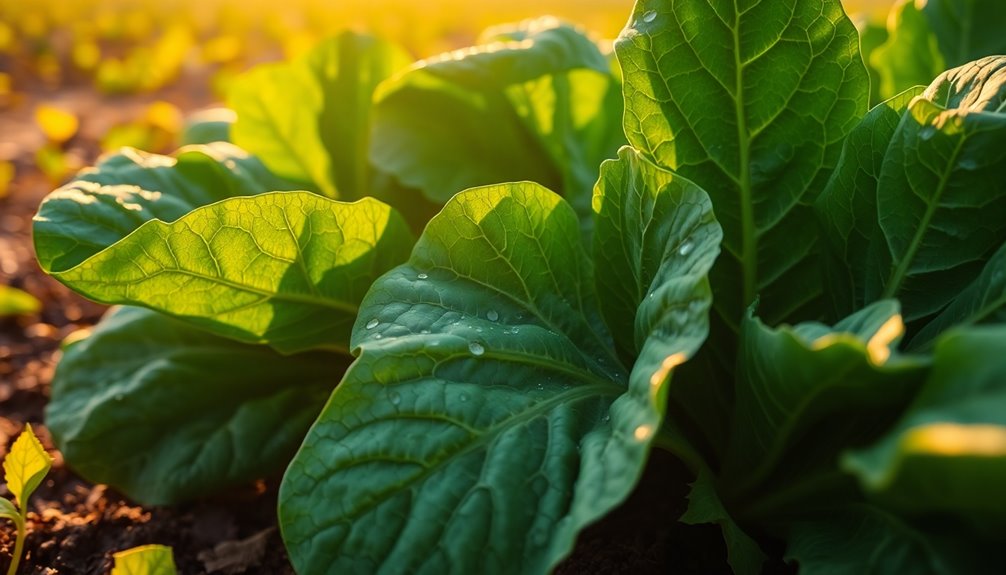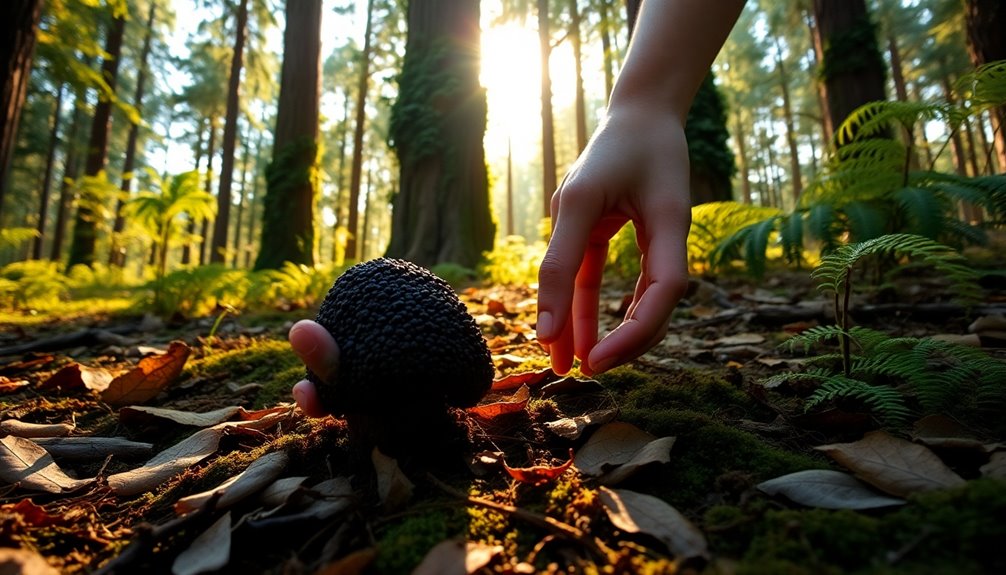To effectively clean your wild mushrooms, use a mushroom brush to gently wipe or trim any dirty parts. Avoid soaking them in water in order to maintain their flavor and texture. Identify safe species by taking note of key characteristics and consulting experts if unsure. Handle mushrooms delicately by brushing off dirt and storing them in breathable containers. To dry them, use paper bags with proper air circulation to prevent mold. Storing them airtight in ziplock bags will ensure freshness. Remember, cleaning is crucial for both quality and safety. Master these steps to fully enjoy the potential of your foraged finds.
Key Takeaways
- Use a soft brush for delicate cleaning.
- Avoid soaking mushrooms in water.
- Trim tough or dirty parts.
- Inspect closely for contaminants.
- Handle with care to prevent damage.
Essential Mushroom Cleaning Tools
To effectively clean your wild mushroom finds, essential tools like a mushroom brush are indispensable. A mushroom brush with soft bristles is perfect for delicately removing dirt and debris from the mushrooms without damaging their delicate flesh. This tool guarantees a thorough cleaning process while maintaining the mushrooms' integrity.
Using a mushroom brush allows you to gently sweep away any soil or debris that may be clinging to the mushrooms. The soft bristles effectively dislodge particles without causing harm to the fragile surfaces of the mushrooms. By utilizing a mushroom brush, you can make sure that your wild finds are free from unwanted contaminants before preparing them for cooking.
Remember, a clean mushroom is a tasty mushroom!
In your foraging adventures, always carry a mushroom brush to make certain that your wild treasures are properly cleaned and ready for consumption. This simple tool can make a significant difference in the quality of your foraged mushrooms, ensuring a delightful culinary experience.
Field Cleaning Techniques

When foraging for wild mushrooms, remember to use a soft brush or cloth to gently remove dirt and debris from your finds.
Avoid soaking the mushrooms in water to prevent them from losing flavor and becoming waterlogged.
Trimming any tough or dirty parts before storing or drying the mushrooms will help maintain their quality.
Brushing off Dirt
How can you effectively remove dirt from wild foraged mushrooms while preserving their delicate structures?
Brushing off dirt is an important step in the field cleaning process to make sure your mushrooms are free of debris and ready for further preparation. Here's how you can master this technique:
- Use a soft-bristled brush or cloth to gently remove dirt from the mushroom's surface.
- Brush in a circular motion to dislodge any stubborn particles without damaging the mushroom.
- Pay special attention to crevices and folds where dirt tends to accumulate.
- Ensure thorough brushing to maintain the freshness and flavor of your wild finds.
Brushing off dirt is necessary before moving on to the next cleaning steps to prevent spoilage and enhance the overall quality of your mushrooms.
Rinsing With Care
What precautions should you take when rinsing wild foraged mushrooms in the field to guarantee their quality and flavor are preserved?
When it comes to cleaning your mushrooms, it's crucial to rinse them with care. Use a gentle stream of water to wash off any remaining dirt or debris after brushing them lightly with a soft brush or cloth. Avoid soaking the mushrooms in water as this can cause them to absorb excess moisture, impacting their texture and taste.
While rinsing, inspect the mushrooms closely for any signs of insects or other contaminants that may have nestled in the crevices. Remove any tough or dirty parts by trimming them off during the cleaning process.
Identifying Safe Mushroom Species

To accurately identify safe mushroom species, consult local field guides or experts for guidance. When mushroom identification is important for your safety, follow these key tips:
- Look for Key Characteristics: Differentiate between edible and poisonous mushrooms by examining factors like color, shape, gills, and spore print.
- Avoid Certain Features: Steer clear of mushrooms with white gills, a ring on the stem, or a cup at the base, as they may be toxic.
- Consider Habitat: Pay attention to the environment where the mushroom is growing, as specific species thrive in particular habitats.
- Seek Professional Help: If uncertain, seek advice from experienced foragers or mycologists to guarantee the safety of your finds.
- Err on the Side of Caution: When in doubt, it's best to refrain from harvesting or consuming any wild mushrooms to mitigate potential risks.
Proper Mushroom Handling Practices

When handling wild mushrooms, it's important to treat them with care to maintain their quality and flavor.
Properly cleaning techniques involve gently brushing off dirt and debris, avoiding soaking in water, and using a damp cloth for wiping if necessary.
Handling Wild Mushrooms Safely
While foraging for wild mushrooms, always wear gloves to prevent skin irritation or allergic reactions. Handling wild mushrooms safely is essential to avoid any potential risks associated with these natural treasures. Follow these guidelines to make sure you handle wild mushrooms properly:
- Use a mushroom brush or a damp cloth: Gently clean off dirt and debris from the mushrooms without soaking them in water.
- Avoid soaking wild mushrooms: Since they're porous, they can absorb moisture, leading to spoilage.
- Trim any tough or dirty parts: Before cooking or drying the mushrooms for preservation, make sure to remove any undesirable portions.
- Store cleaned wild mushrooms properly: Place them in a breathable container or paper bag in the refrigerator to maintain freshness and prevent mold growth.
Cleaning Techniques for Mushrooms
Properly cleaning wild mushrooms involves gently brushing off dirt and debris to guarantee they're free from surface impurities. As a Mushroom Hunter, you should handle your finds with care to maintain their quality.
After brushing off the dirt, use a damp cloth to wipe the mushrooms clean. Avoid soaking them in water, as this can safeguard their texture and flavor. Once wiped, pat the mushrooms dry with a paper towel to remove any excess moisture before cooking or storing them.
Before cleaning, make sure to inspect the mushrooms and trim any tough or dirty parts. This step ensures that only the freshest and cleanest portions are used in your dishes.
Storing Foraged Mushrooms
To maintain the freshness and quality of your foraged mushrooms, store them in a cool, dry place. Important storage practices are vital for preserving the flavor, texture, and nutritional value of your wild finds.
Here are some tips to help you store your mushrooms effectively:
- Store fresh mushrooms in a cool, dry place to prevent spoilage.
- Pre-dry mushrooms in paper or mesh bags to regulate moisture levels before long-term storage.
- Use airtight containers, like gallon ziplock bags, to store dried mushrooms and maintain their quality.
- Make sure mushrooms are thoroughly dried before storage to prevent mold growth and extend their shelf life.
Remember that proper storage of foraged mushrooms is essential for maintaining their overall quality and ensuring a delightful culinary experience.
Tips for Cleaning Mushrooms at Home

Gently brush off dirt and debris from your wild foraged mushrooms using a soft brush or cloth. Be sure to handle them delicately to avoid damaging the delicate flesh.
Avoid soaking the mushrooms in water as they can absorb it, becoming soggy and losing flavor. Instead, use a gentle touch to wipe away any dirt.
Before cleaning, trim any tough or dirty parts of the mushrooms to make certain only the best parts are used in your dishes.
Once you've brushed off the debris, pat the mushrooms dry with a paper towel to remove any excess moisture. This step is vital to prevent the mushrooms from becoming waterlogged during cooking.
Cleaning mushrooms at home is an important step in the process of preparing them for cooking. By following these tips, you can preserve the natural flavors and textures of the mushrooms, enhancing the overall taste of your dishes.
Storing Foraged Mushrooms

For best preservation of your foraged mushrooms, store them in a cool, dry place to maintain their quality and freshness. Additionally, consider the following tips to guarantee your mushrooms stay in top condition:
- Use Mesh Bags:
Opt for mesh bags to allow air circulation around the mushrooms, preventing moisture buildup.
- Regulate Moisture Levels:
Paper bags or mesh bags are ideal for controlling moisture levels before drying the mushrooms.
- Choose Gallon Ziplock Bags:
When storing dried mushrooms, gallon ziplock bags work wonders in preventing spoilage.
- Ensure Thorough Dryness:
Before storage, make sure your mushrooms are completely dry to extend their shelf life.
- Use Airtight Containers:
Store dehydrated mushrooms in airtight containers at a low temperature for long-term preservation.
Ensuring Mushroom Safety and Quality

Guarantee the safety and quality of your foraged mushrooms by following proper cleaning and storage practices. When it comes to edible mushrooms, ensuring their safety is paramount. Properly cleaning wild foraged mushrooms helps remove dirt, debris, and potential contaminants that could compromise their quality. Thoroughly drying mushrooms is essential to prevent spoilage and maintain their flavor and texture. Storing mushrooms in cool, dry conditions can help prolong their shelf life, while utilizing airtight containers for storage can further protect them from moisture and pests. Remember, following safety practices and proper identification methods is crucial for avoiding harmful or toxic mushrooms. To help you understand better, take a look at the table below comparing the do's and don'ts of ensuring mushroom safety and quality.
| Do's | Don'ts |
|---|---|
| Clean mushrooms with a brush | Soak mushrooms in water for long |
| Dry mushrooms thoroughly | Store mushrooms in plastic bags |
| Store mushrooms in a cool place | Keep mushrooms in a damp environment |
| Use airtight containers for storage | Expose mushrooms to direct sunlight |
Frequently Asked Questions
What Is the Trick to Finding the Mushroom?
To find the mushroom, search near trees and rotting logs. Notice cap shape, gill structure, and stem color. Look for morels in moist areas like forests or after rain. Join mycology clubs or use apps for identification.
What Is the Saying About Mushroom Forager?
The saying emphasizes the importance of caution and experience in mushroom foraging. It reminds you to approach hunting with respect for nature and learn from seasoned experts. Safety and proper identification are essential.
What Are the Rules for Mushroom Foraging?
When mushroom foraging, remember to always follow the rules: get permission, respect nature, avoid polluted areas, learn proper identification, and consider joining a mycological society. It's better to be safe than sorry!
What Is the Best Mushroom Field Guide?
When choosing a mushroom field guide, opt for one with detailed descriptions, clear images, and habitat information specific to your region. Look for pocket-sized options for portability, and consider online resources for real-time identification assistance. Recommendations from experienced foragers are valuable.
Conclusion
Happy foraging and happy cleaning! Remember, the key to a successful mushroom foraging experience is to always stay informed, cautious, and prepared.
By following these simple cleaning techniques and safety guidelines, you can enjoy the delicious flavors of your wild finds with peace of mind.
So grab your basket, put on your boots, and head out into the forest – just make sure to leave the poisonous mushrooms for someone else to clean!










